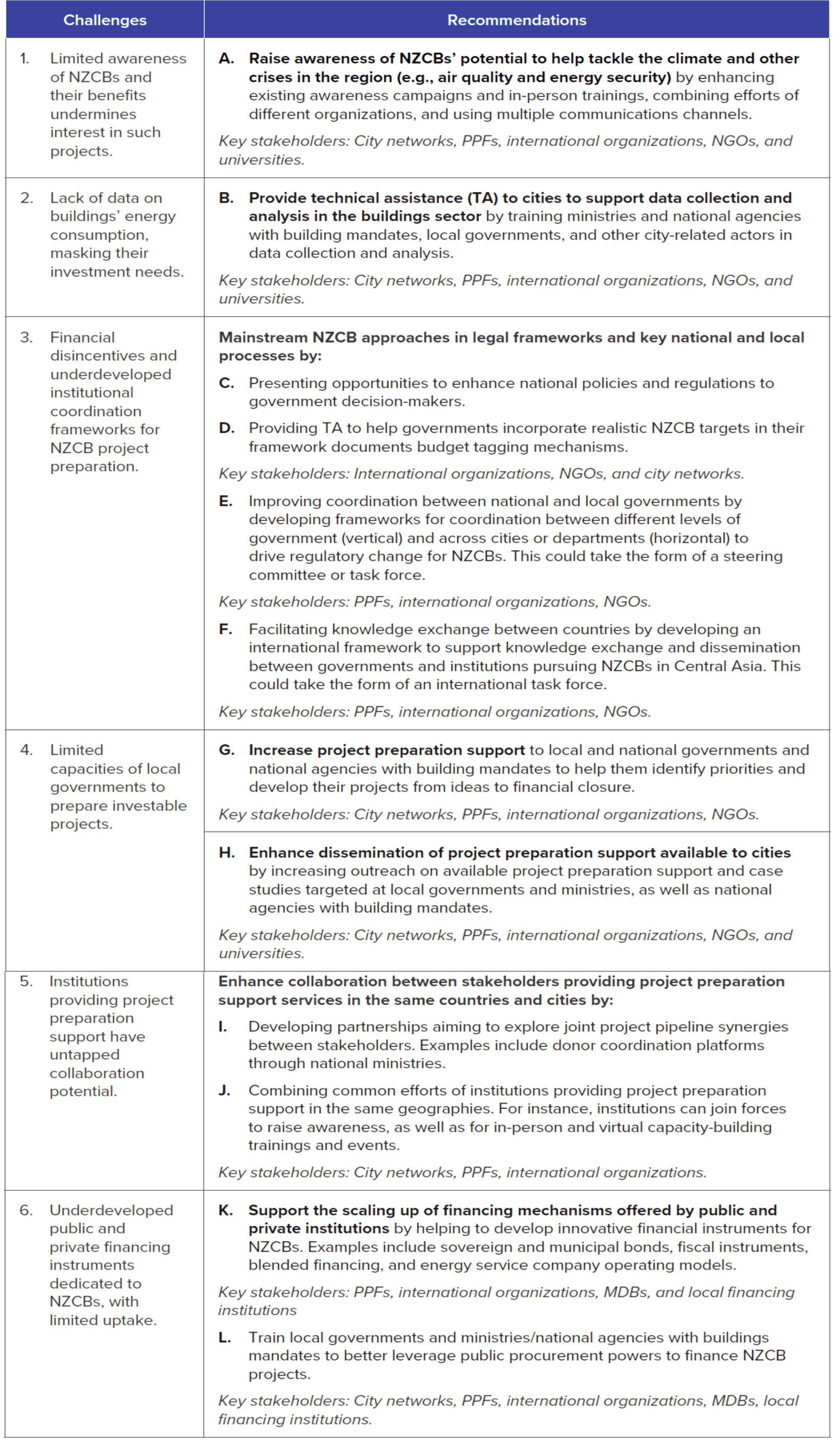Scaling up net zero carbon buildings (NZCBs) is critical to meeting Central Asia’s climate mitigation goals.[1] Buildings account for up to 70-80% of total emissions from Central Asian cities’ buildings, transport, and waste sectors combined, making their decarbonization crucial to expediting the region’s path to climate neutrality (GCoM, upcoming). However, scaling climate investment in the buildings sector remains challenging.
NZCBs are buildings that have achieved decarbonization in all aspects of their energy use, operations, and embodied carbon from materials over their lifespan. While there are challenges in achieving NZCBs at scale in Central Asia and elsewhere, the measures outlined in this report can also assist in achieving green and low-carbon buildings, which have reduced carbon footprints without reaching the decarbonization levels of NZCBs.
This report builds on learnings from the Cities Climate Finance Leadership Alliance (CCFLA) Central Asia Hub, whose members have prioritized buildings’ decarbonization as a focal area for the region, particularly for Kazakhstan and Uzbekistan. The Hub is convening CCFLA members and key regional stakeholders to develop action-oriented knowledge products and foster collaboration. Most regionally active CCFLA members engage in project preparation activities. This paper presents an overview of the landscape of project preparation support for the sector in Central Asia, identifies challenges, and provides recommendations to accelerate action.
The report also builds on CCFLA’s global work on NZCBs, including its Financing Net Zero Carbon Buildings (2022) and Net Zero Carbon Buildings in Cities report (2023), which, respectively, analyze the challenges and priorities relevant to cities in decarbonizing the buildings sector and the interdependencies between barriers and policy and finance instruments available to cities to achieve systemic transformation in the sector.
KEY FINDINGS
Buildings’ decarbonization is fundamental to achieving the Nationally Determined Contributions of Central Asian countries. This paper focuses on Kazakhstan and Uzbekistan, where about 50% of the final energy use is attributable to the buildings sector (Belyi, 2023; JICA, 2023). Residential buildings are particularly relevant, as they account for 34% of final energy use in Kazakhstan and 39% in Uzbekistan (Belyi, 2023; JICA, 2023).
Recently, both Kazakhstan and Uzbekistan have intensified their government policy focus on decarbonizing buildings. Uzbekistan’s government aims to improve the overall economy’s energy efficiency by 50% by 2030 (LexUz, 2020). It concurrently aims to outfit a substantial portion of the country’s building rooftops with both solar PV and solar water heaters (IEA, 2022). In Kazakhstan, the national government targets a 15% reduction in the economy’s energy intensity by 2029 through prioritizing energy efficiency in buildings (EEDI, 2023). However, there has been little progress on investment and project implementation to date.
To realize their ambitions to decarbonize buildings, these countries need to step up their preparation of investable projects. Project preparation stakeholders in Central Asia focus on four key stages: concept design, pre-feasibility, feasibility, and structuring and transactions. They also conduct enabling activities such as awareness raising and capacity building for institutions, data, policies, and financial frameworks. The viability of NZCB projects in Kazakhstan and Uzbekistan is impaired by large energy subsidies, which cover up to 50% of the energy costs of residential buildings.
We mapped 12 international entities implementing project preparation activities for NZCBs in Kazakhstan and Uzbekistan. These include city networks, project preparation facilities (PPFs), and international organizations, including bilateral and multilateral development banks (MDBs). Broadly, project preparation stakeholders focus their support on either the early stages of the project development, working until the pre-feasibility stage, or full service, developing projects throughout the entire project cycle. Given that some of these organizations have only just begun working in Central Asia, there is great potential for them to collaborate on fostering NZCB project pipelines.
We identified 6 key challenges related to NZCB project preparation and have proposed 12 recommendations that could help to overcome them.
Table ES1. Challenges and recommendations to scale NZCB project preparation in Central Asia
[1] The Central Asia region comprises Kazakhstan, Kyrgyzstan, Tajikistan, Turkmenistan, and Uzbekistan.
[2] CCFLA members active in Central Asia include: Deutsche Gesellschaft für Internationale Zusammenarbeit (GIZ), World Bank (WB), European Investment Bank (EIB), European Bank for Reconstruction and Development (EBRD), Global Covenant of Mayors (GCoM), United Nations Development Programme (UNDP), KfW Bankengruppe (KfW), Agence Française de Développement (AFD), and Cities Development Initiative for Asia (CDIA).


